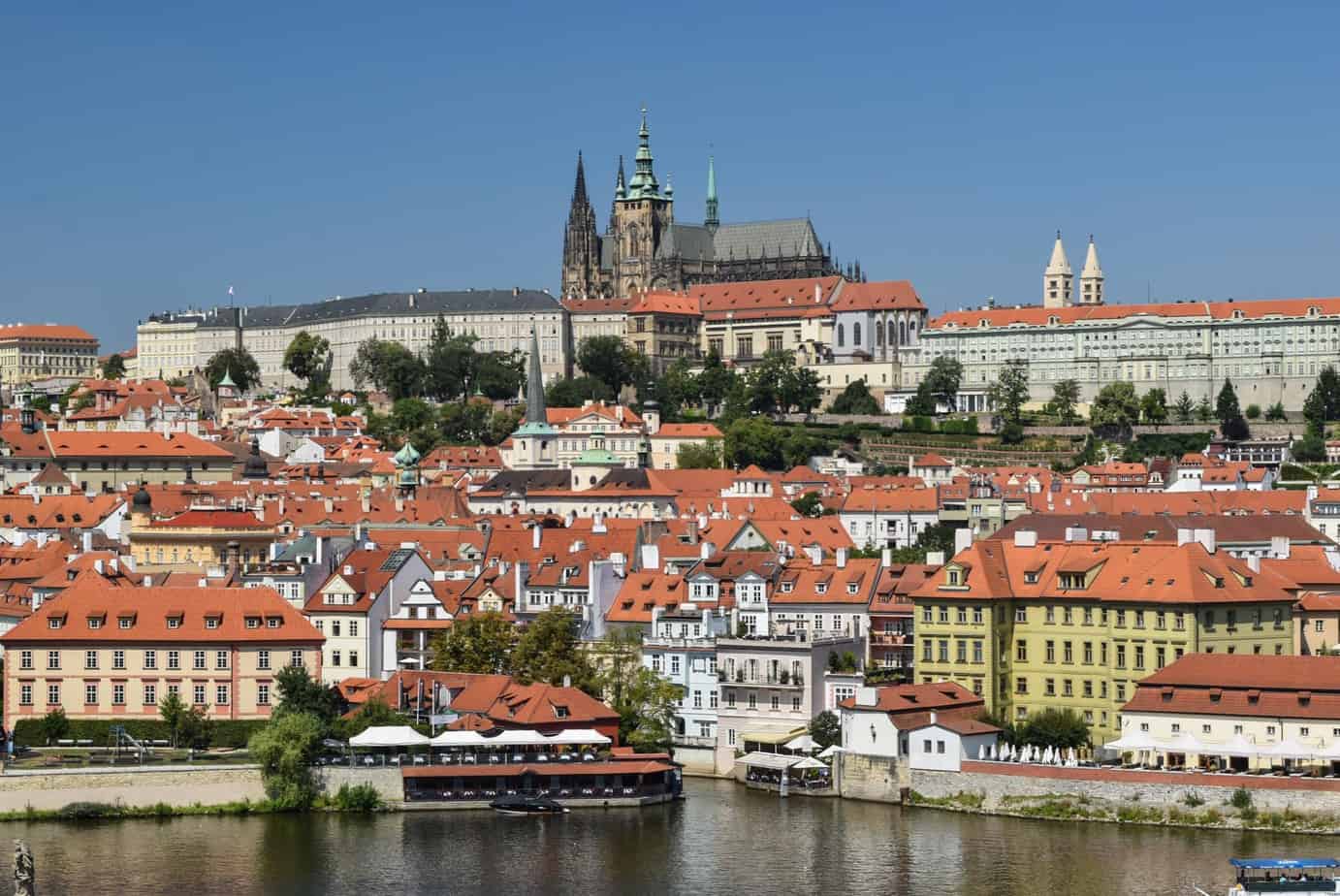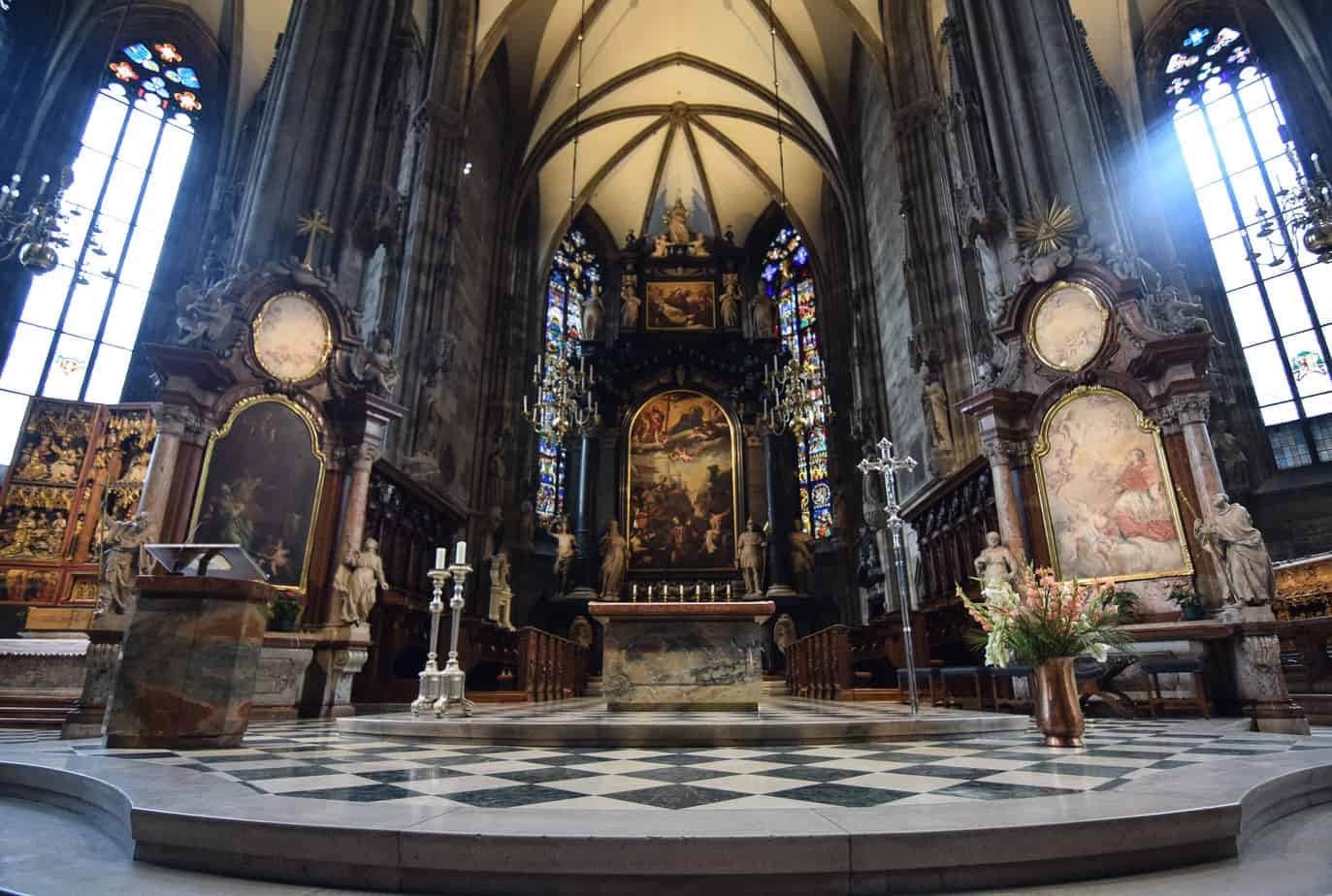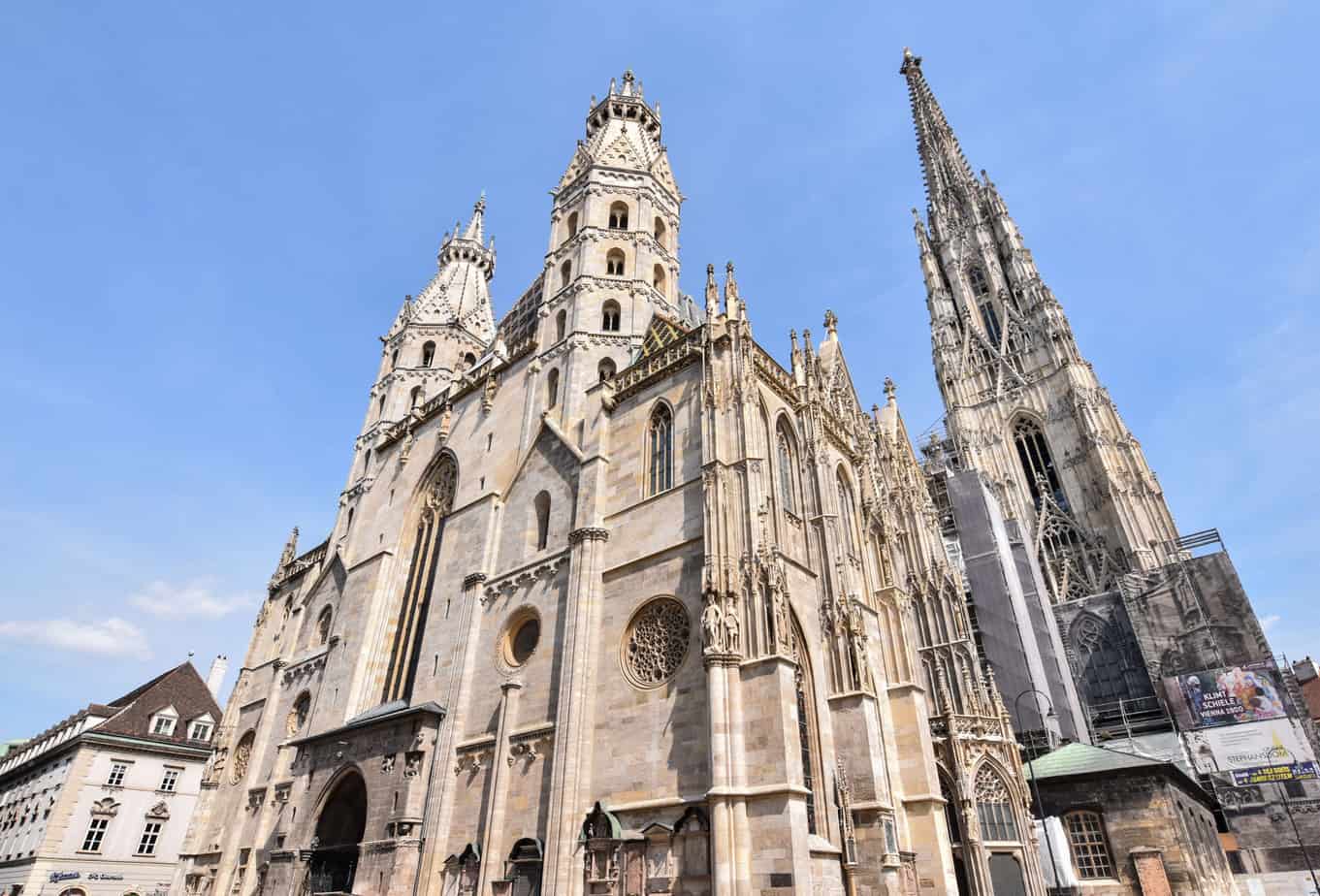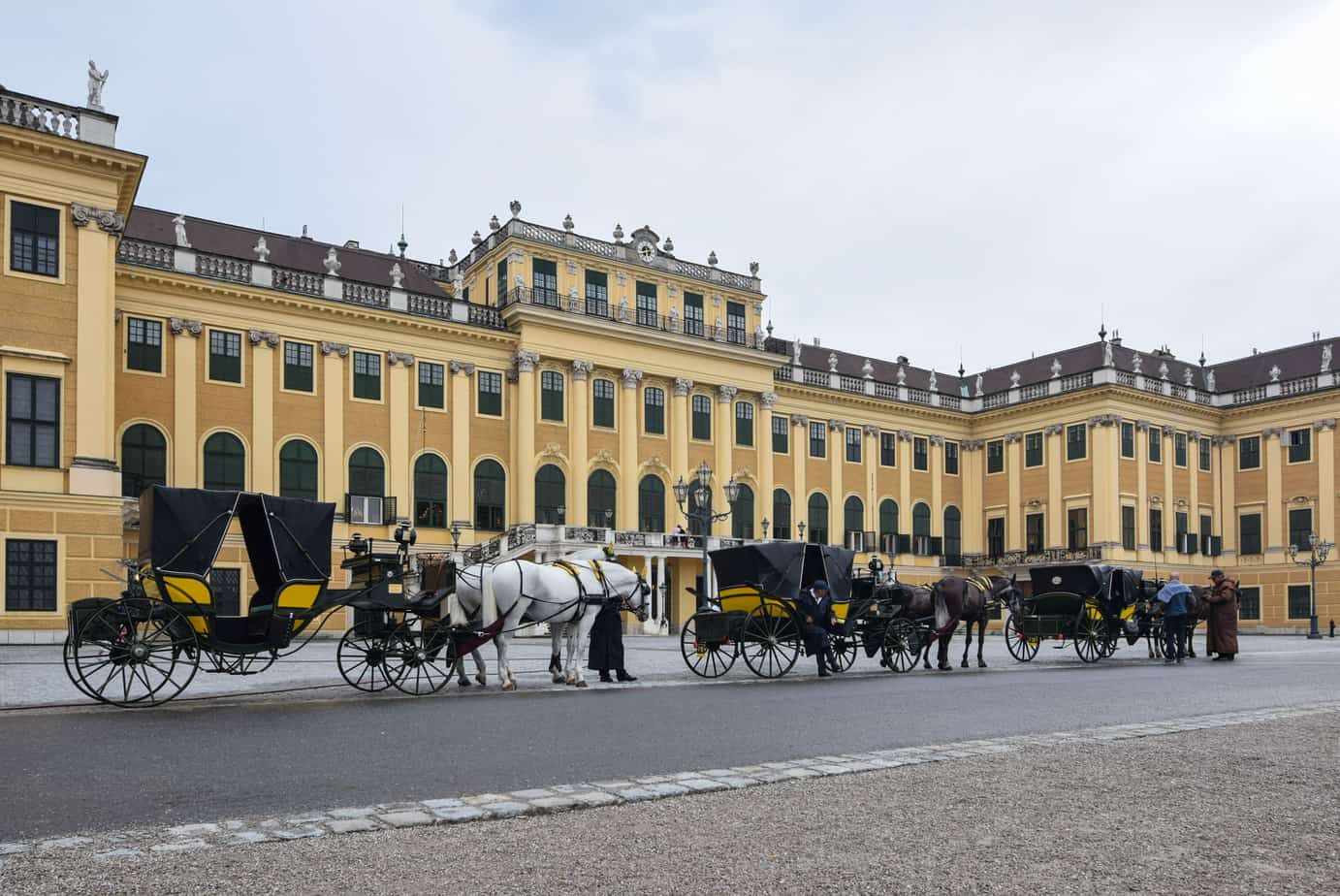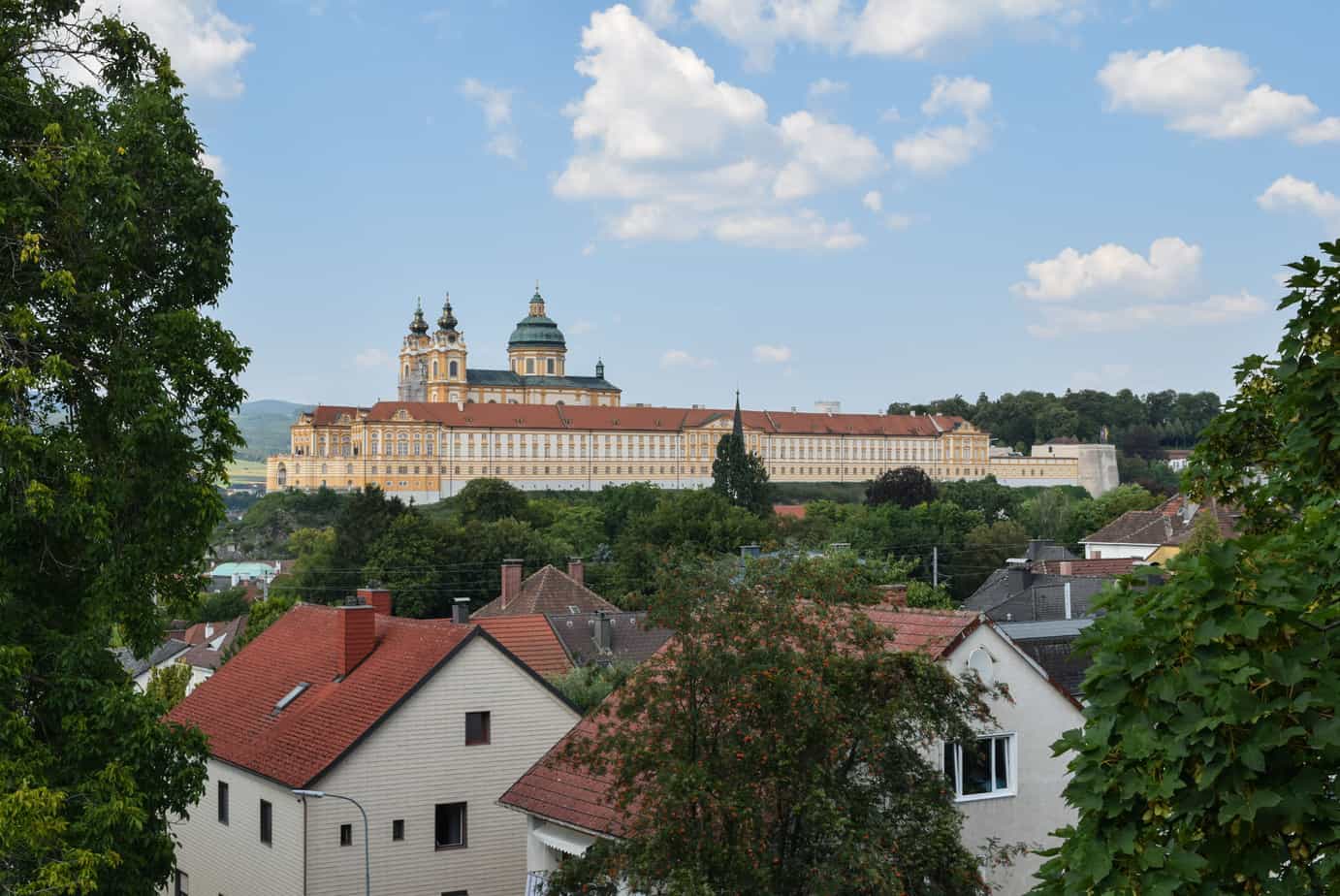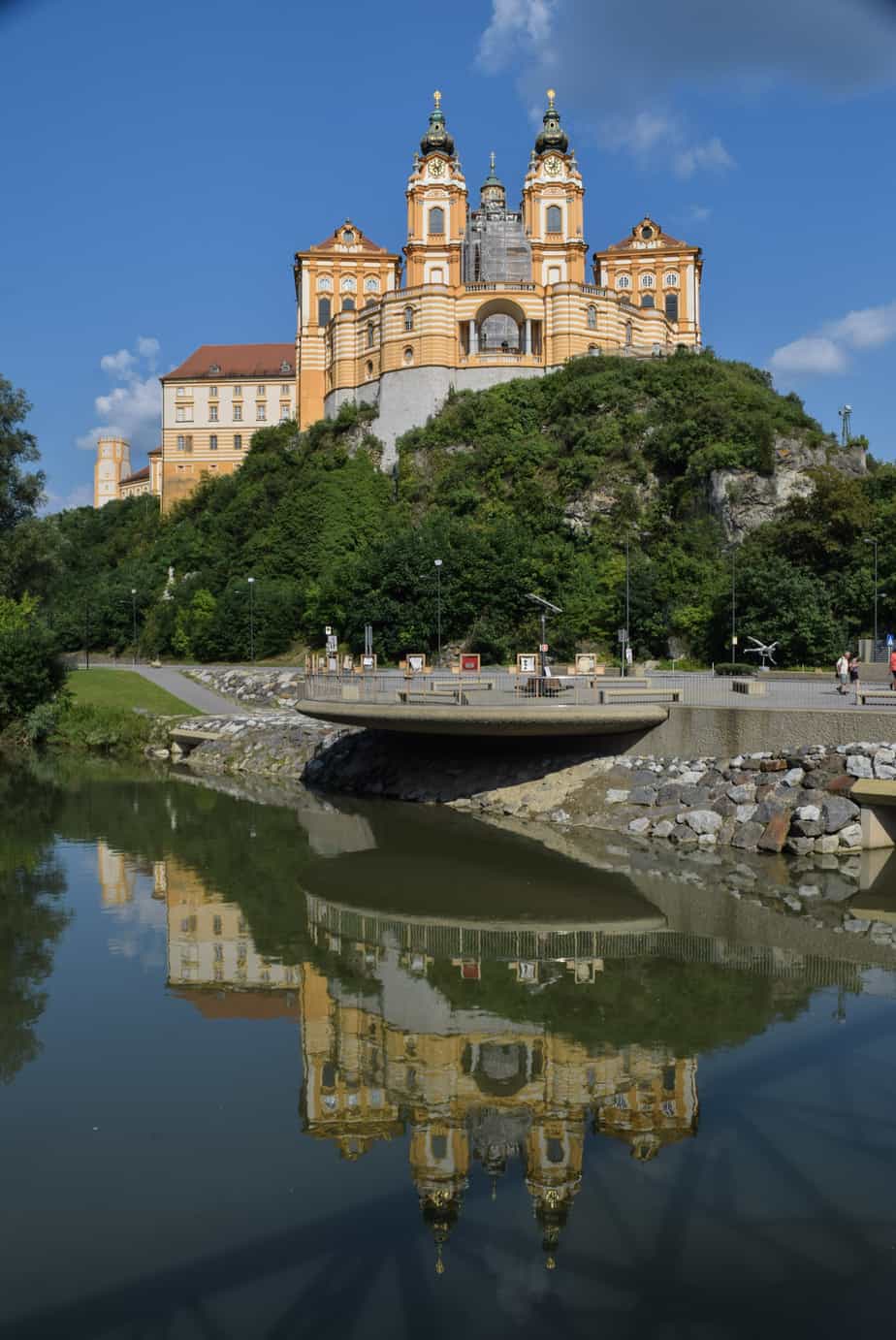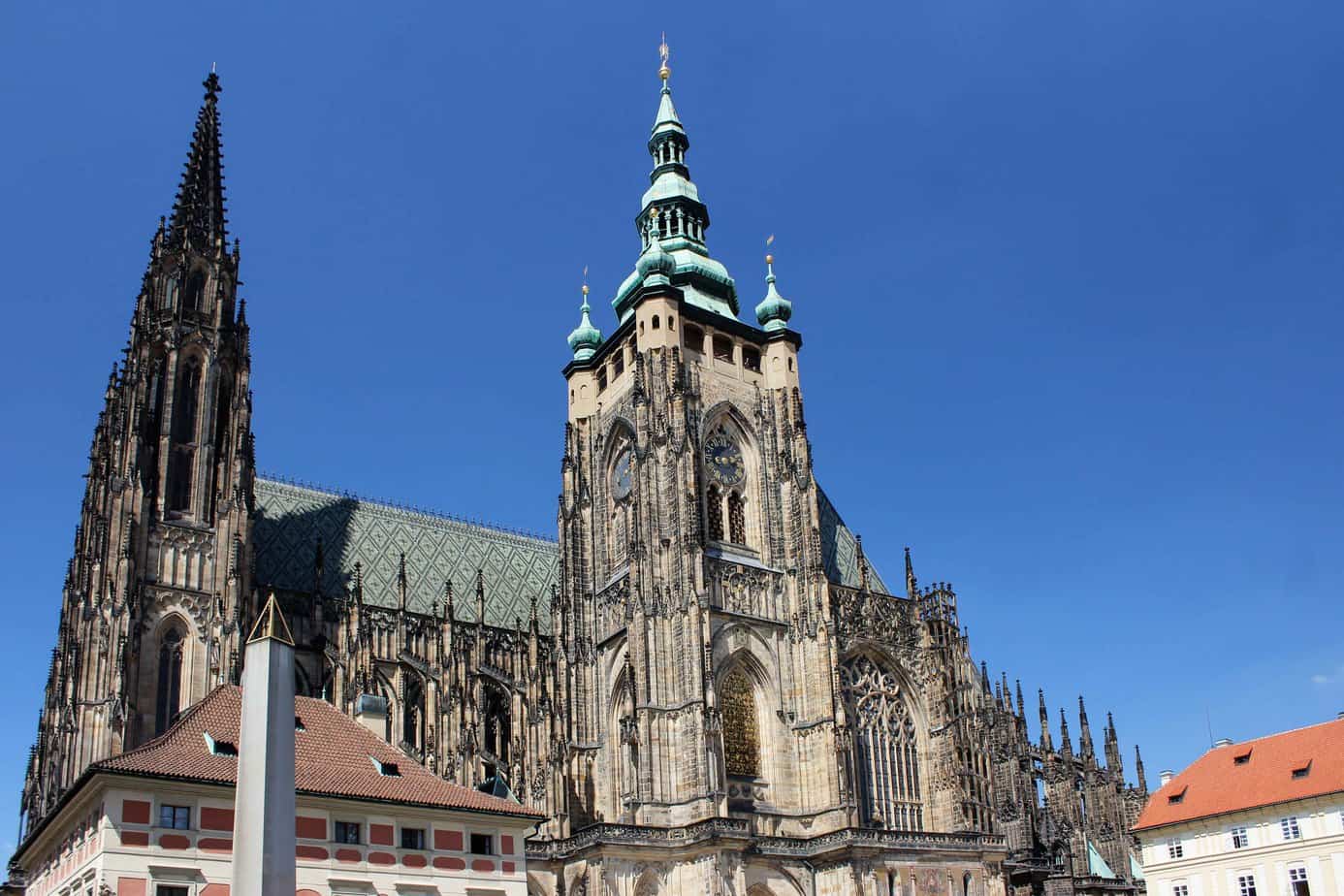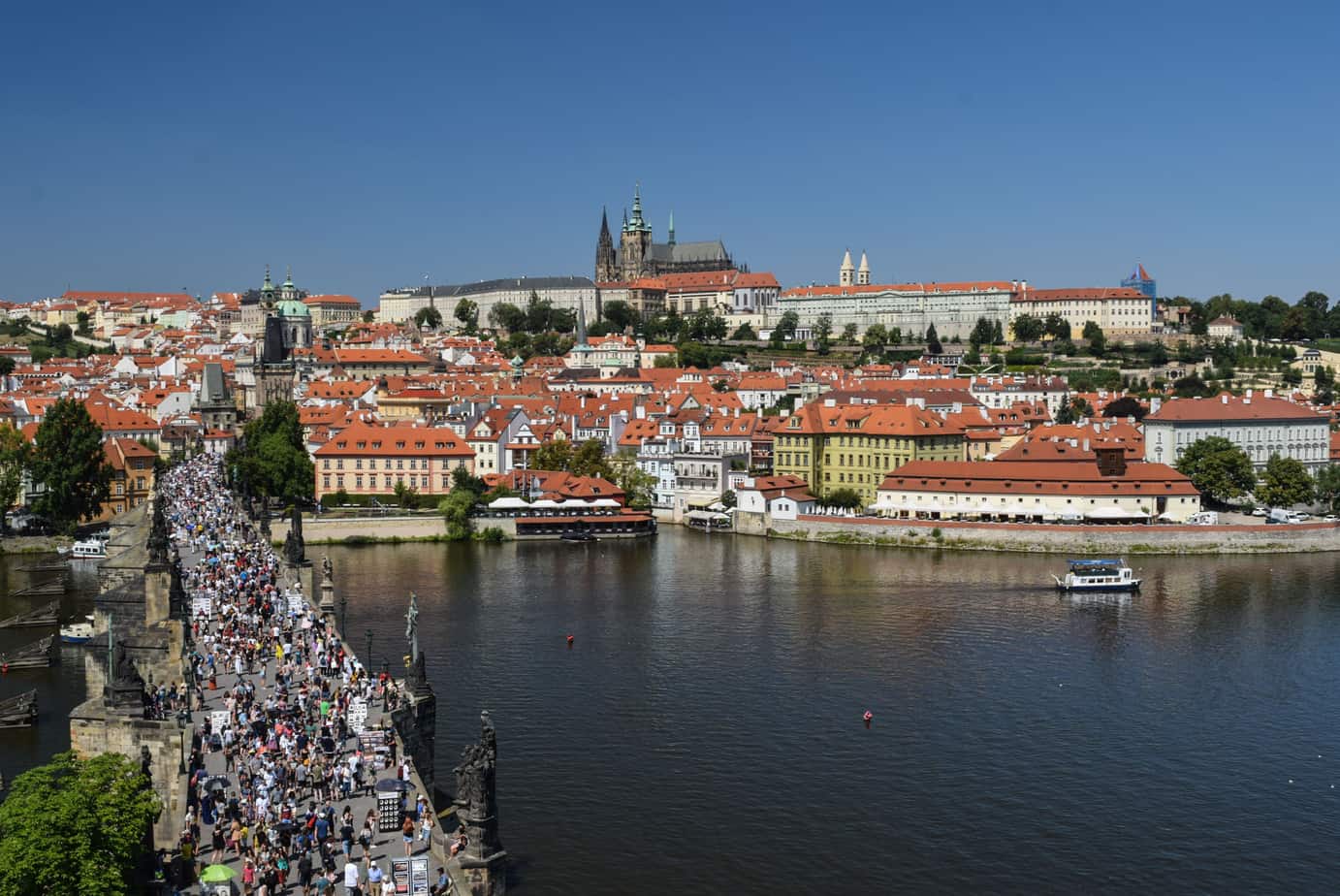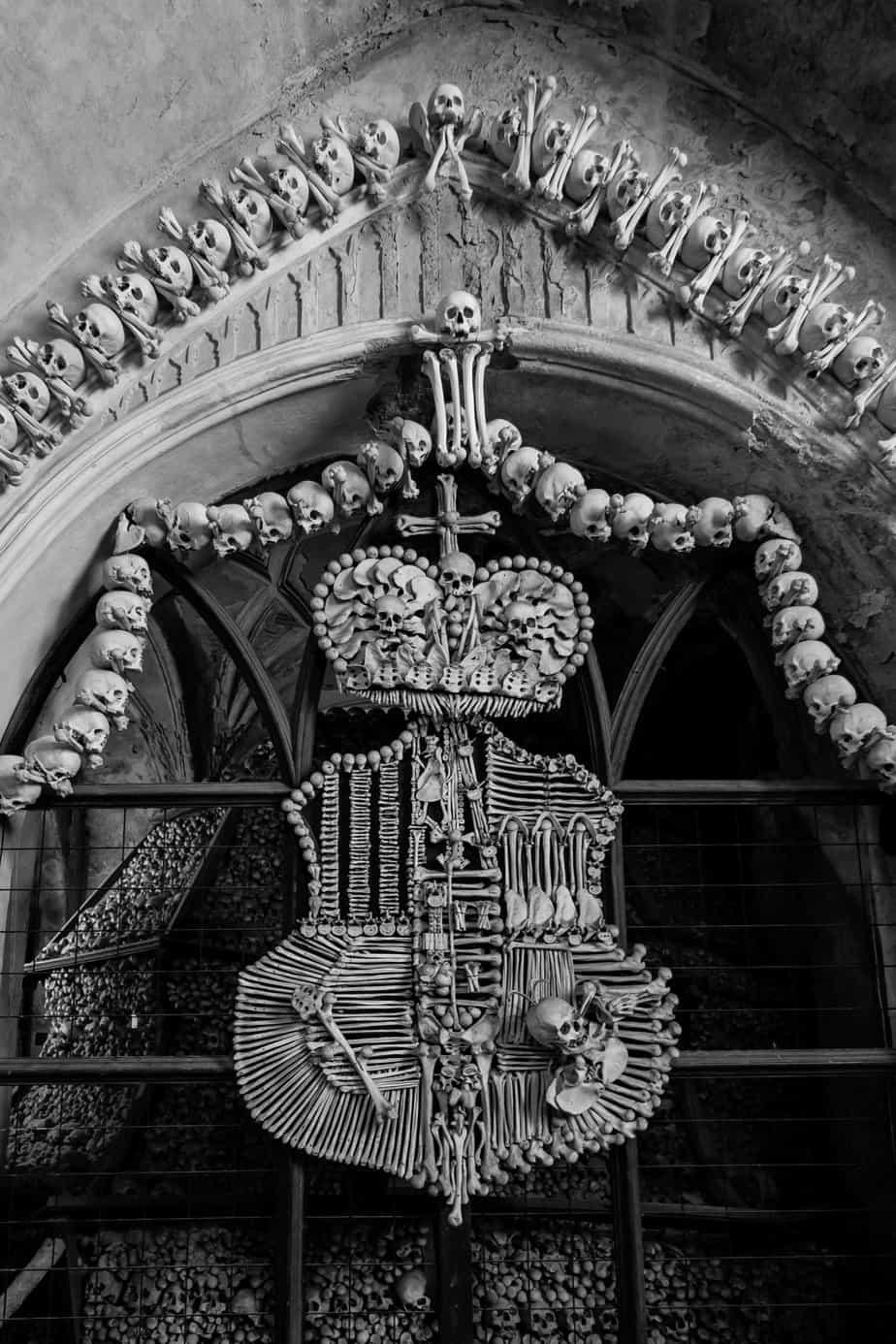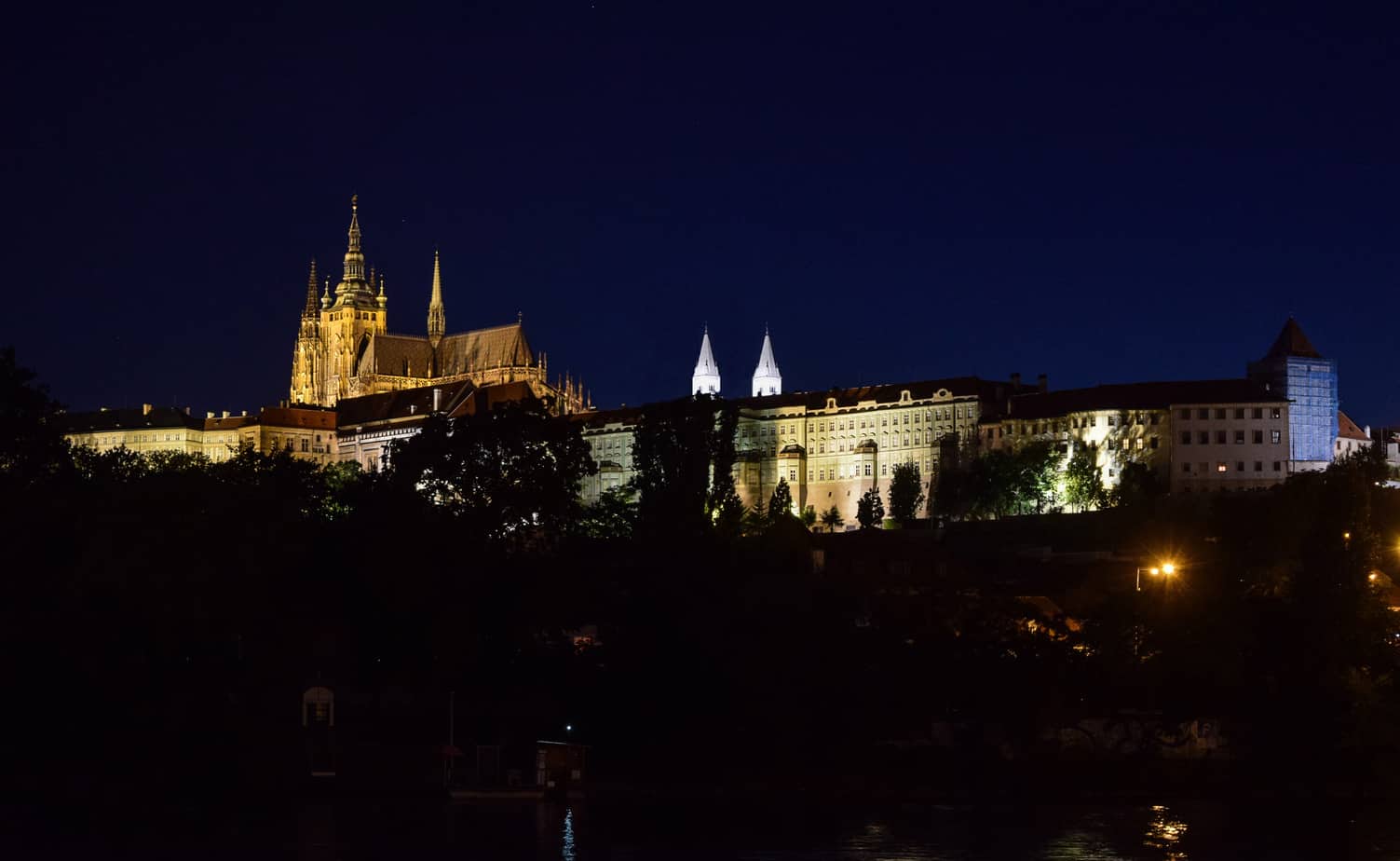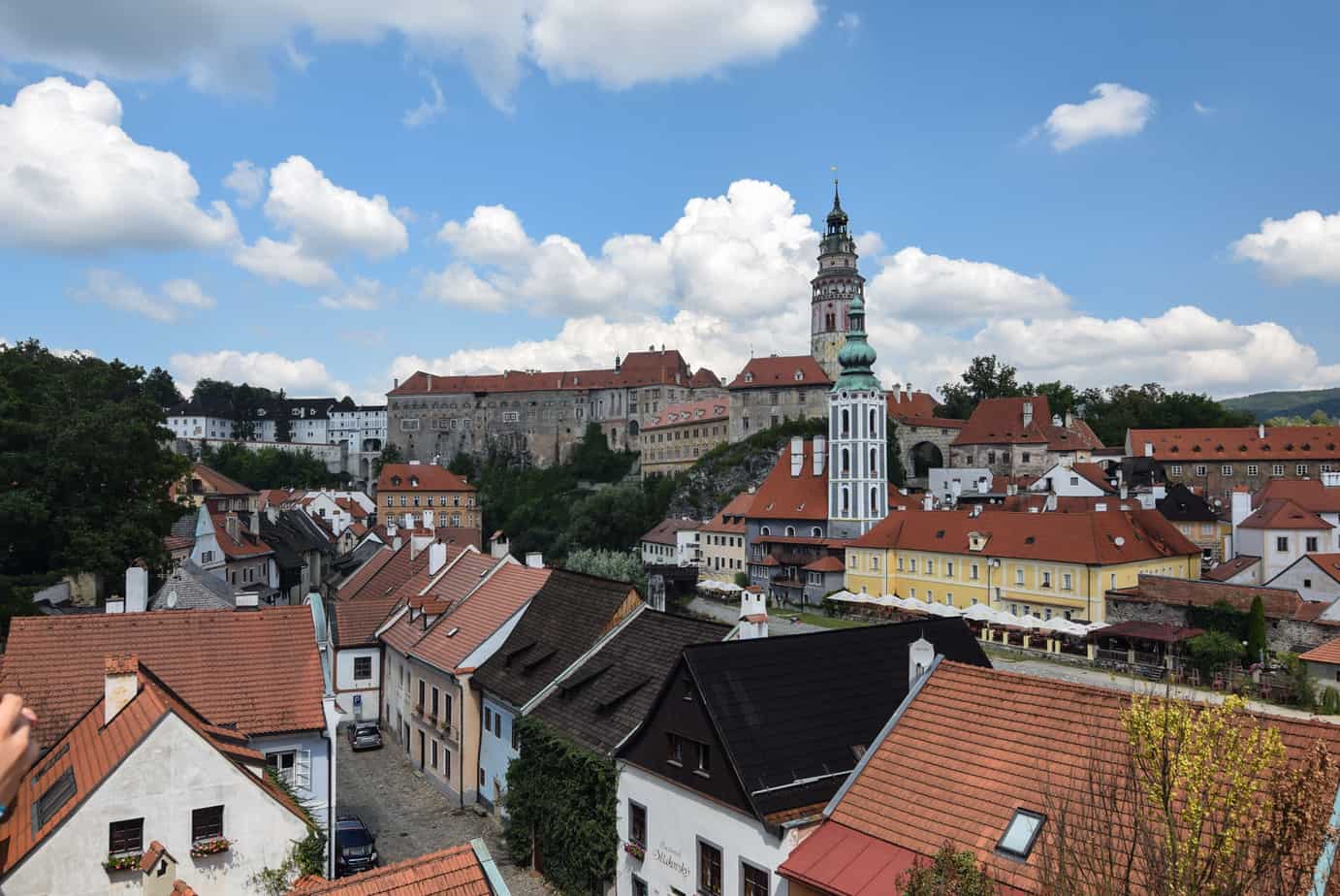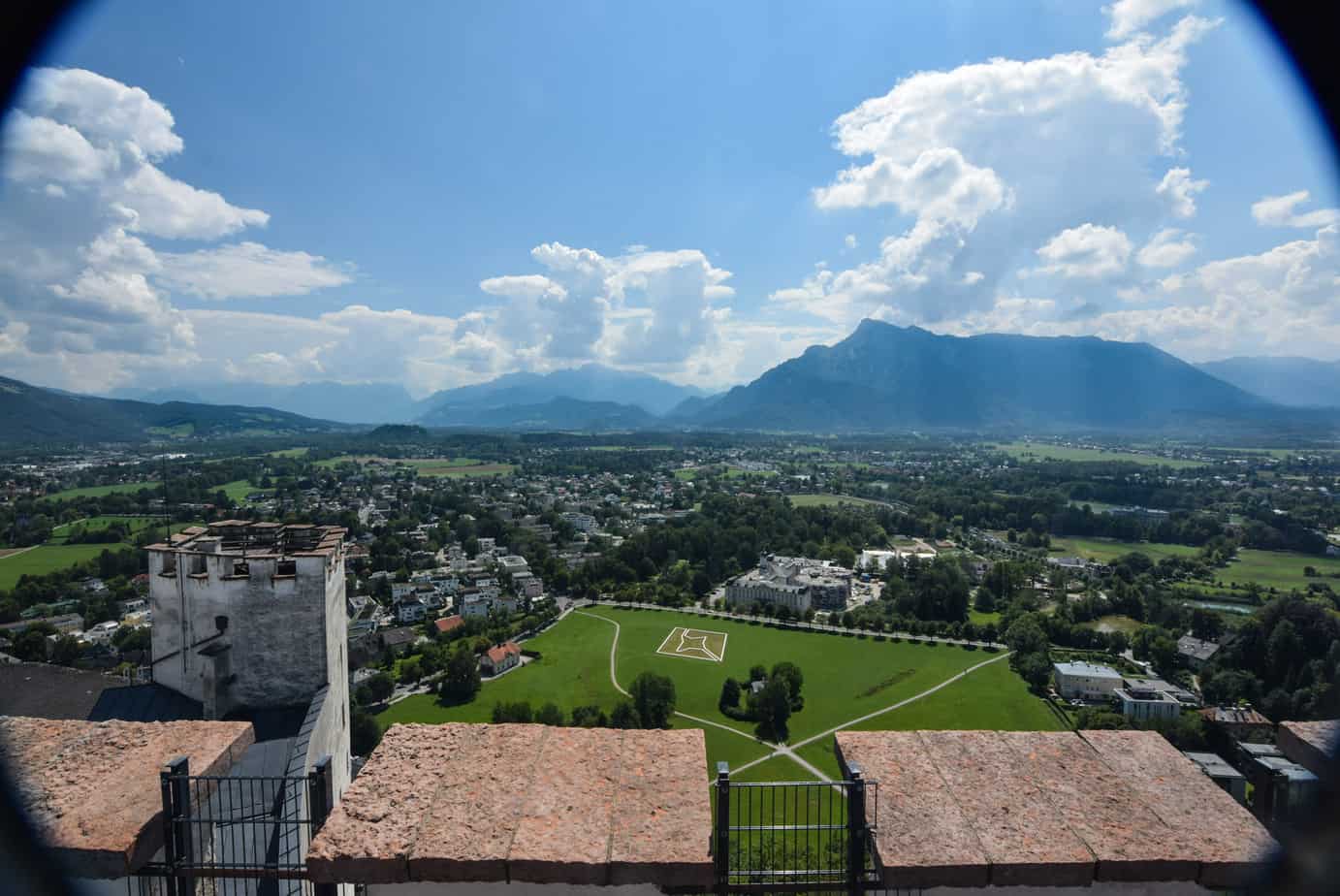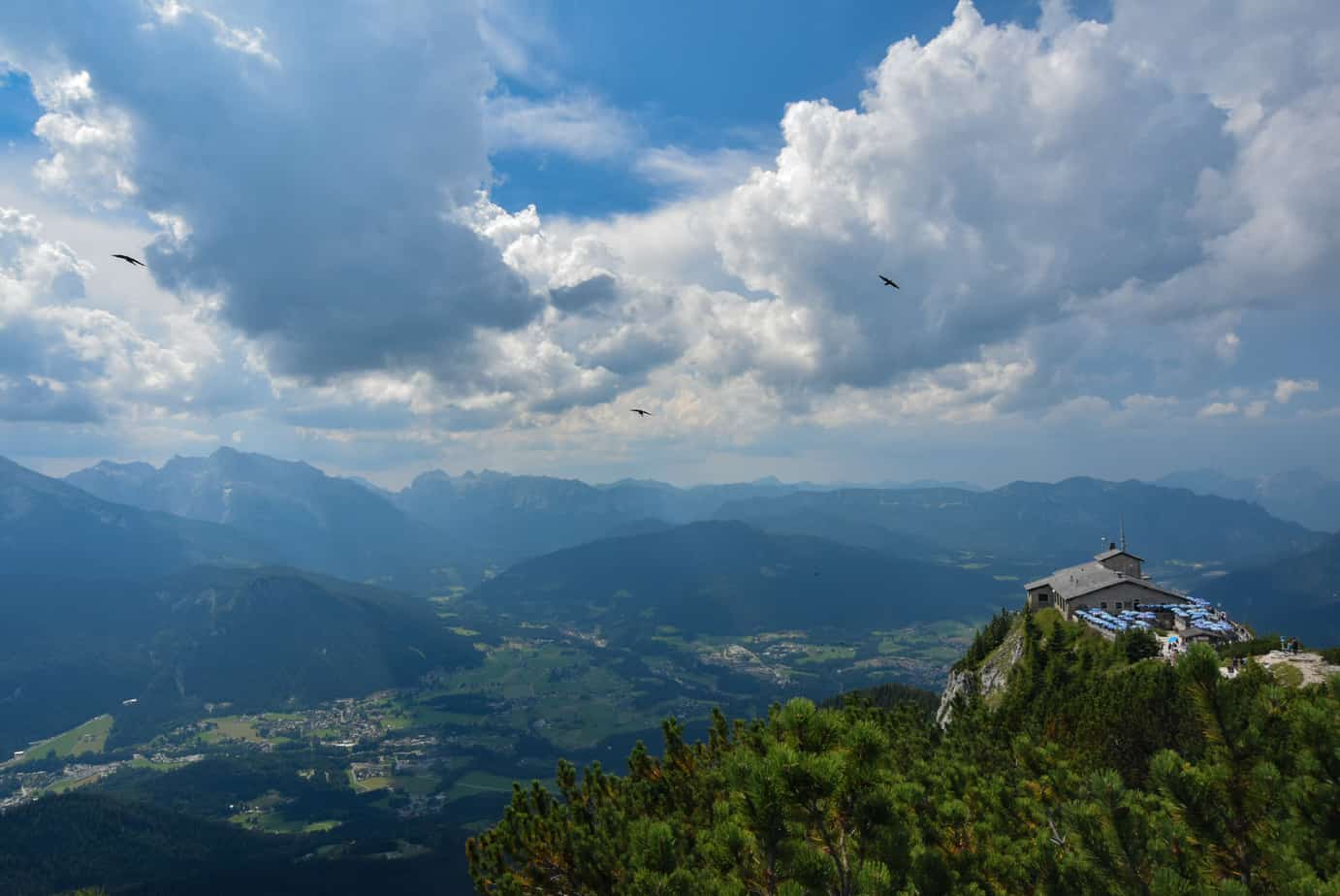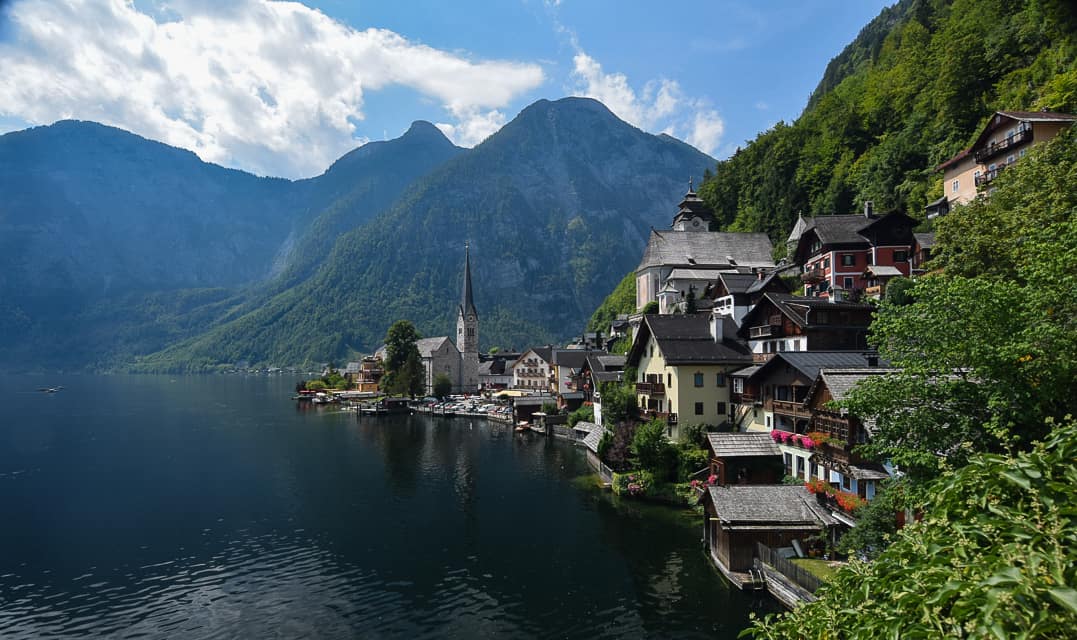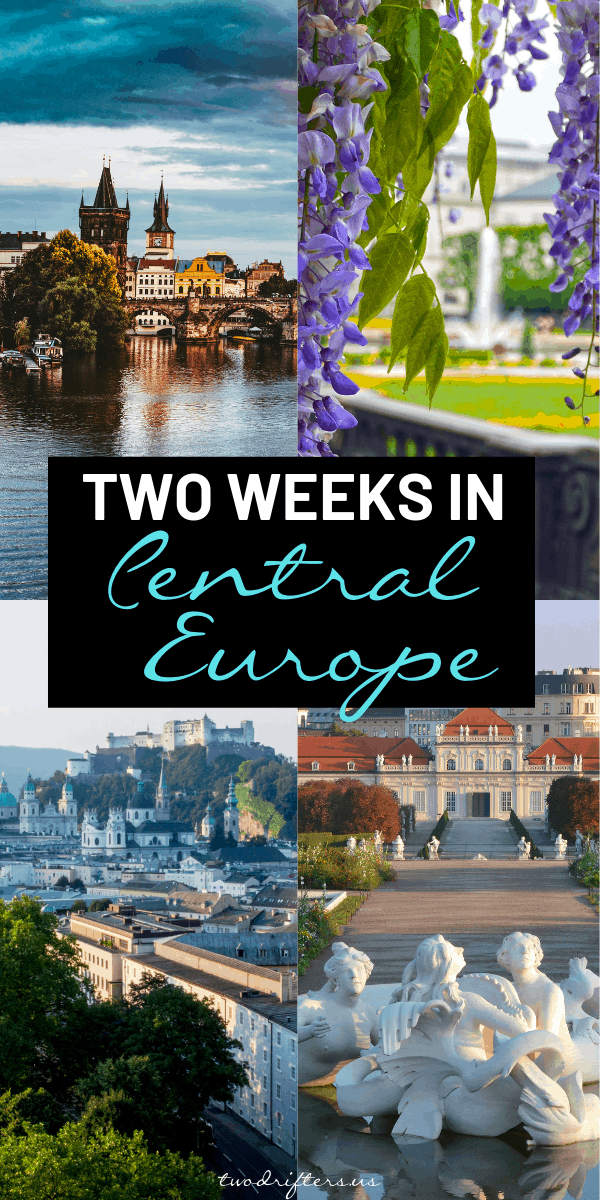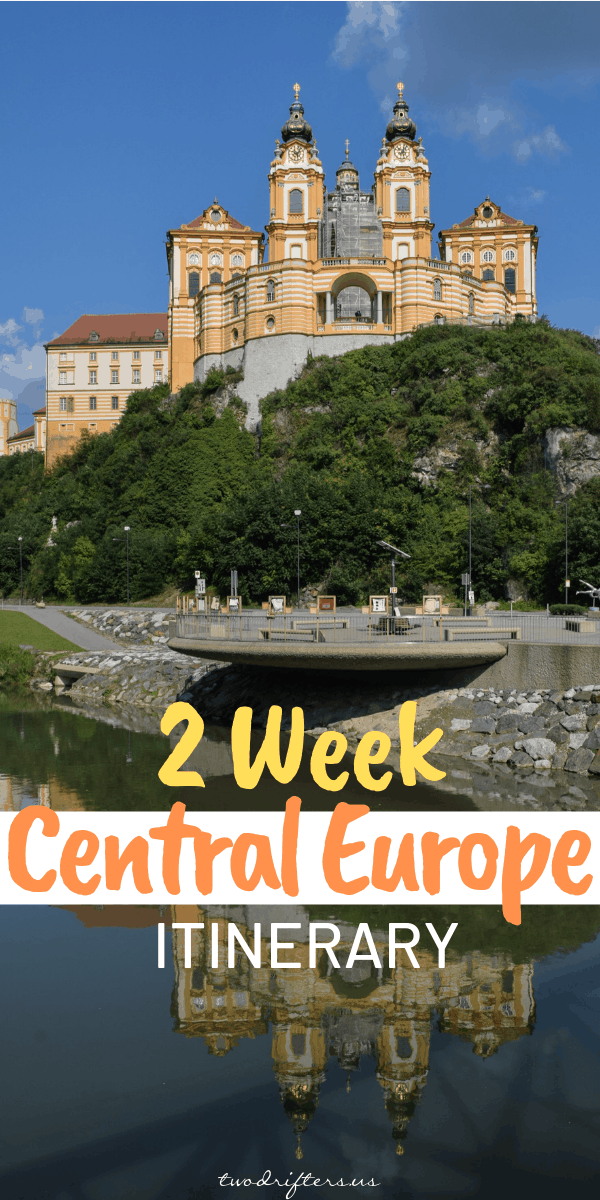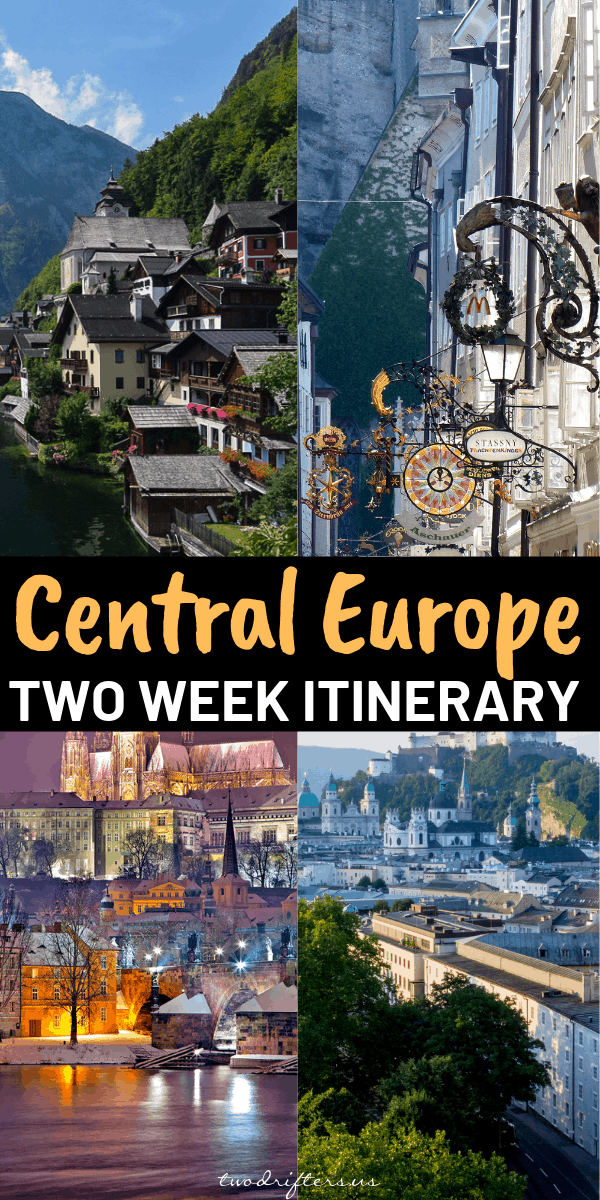This post may contain affiliate links. Read our disclosure page for full details.
So you’re planning two weeks in Europe? Where will you go and what will you see? Europe is filled with so many incredible places it can be nearly impossible to narrow it down. Luckily, two weeks is plenty of time to see some of the best spots Europe has to offer. Especially if you decide to take a European road trip. More specifically, a Central Europe road trip.
It can be hard to decide exactly what to see and where to go on your Europe itinerary, but with two weeks of travel available, Central Europe is an excellent destination. Europe is incredibly driveable, and by sticking with a more narrow region, you can pack a whole lot into this 2 week Europe trip.
A 2 week road trip around Europe is an ideal way to experience the continent. (Especially as a romantic couples trip!) And Central Europe – Austria, southern Germany, Czech Republic, Slovenia, Slovakia, Switzerland, and northern Italy – is a fantastic place to explore some of the historic centers of western culture. Throw in the Alps cutting a jagged path across the heart of the region, and you’ve got the foundations of an epic journey!
In this guest post, our friend Scott from Take Back Roads has created this terrific Europe travel itinerary to help you have the time of your life. While Scott provides an itinerary for driving through Central Europe, you could ostensibly do much of this tour using trains, buses, or air travel. No matter how you choose to get around, read on to see how you can plan the most amazing trip through Central Europe.
A Two Week Central European Road Trip
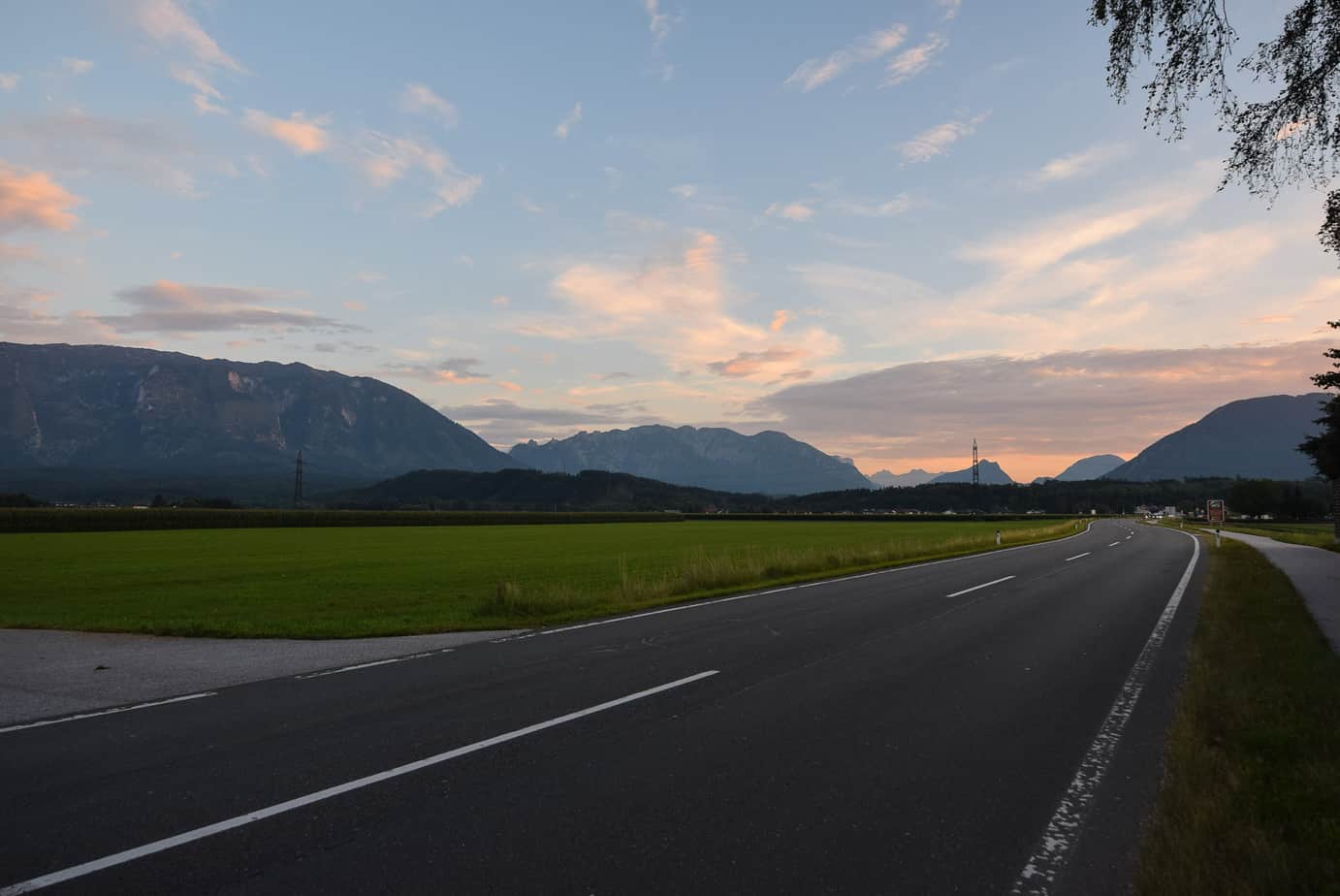
I have a close friend from Austria, which afforded me the opportunity to travel to Europe eight times. Several of those trips have been four to six weeks long. I’ve driven thousands of miles across central Europe, amassing a wealth of knowledge of the best things to see and do there.
Seeing all the places I could recommend would be impossible in two weeks. However, one thing that became abundantly clear during my years of travel is that Europe is a place that begs you to slow down and dig deeper. Make sure you thoroughly explore, allow yourself the opportunity to meander, and take plenty of time to appreciate the small details that make it such a special place. Don’t forget all the incredible cafes and beer halls!
As such, my suggested itinerary is not a comprehensive list of everything there is to see and do in Central Europe; in fact, you’ll only end up visiting half the countries I listed up above! However, the things I’m going to suggest for you to see and do in Austria, Southern Germany, Slovenia and the Czech Republic are dynamic in nature, completely immersive experiences, and will be quite fulfilling for the whole family!
A quick note about the structure of this itinerary – The numbering of each day is based on the overnight, so day 1 is the first overnight, day 2 is the second overnight, and so on. As the host and primary author at Take Back Roads, I will also offer route suggestions throughout, most of which will be back roads that I strongly recommend you take!
Vienna – Days 1,2, and 3
Vienna, the capital city of Austria, is a great place to start your 2 week tour of Europe! Home to one of the best hub airports in Europe, Vienna is an inexpensive and convenient flight destination. Vienna International Airport also offers excellent public transit options.
The city itself offers a massive and dynamic range of things to experience during the three days I suggest you spend here. While three days certainly isn’t enough to see everything that Vienna has to offer, the city’s densely packed central historical district (“Innere Stadt”) and incredibly organized public transit system will allow you to comfortably accomplish quite a lot in that span of time.
Read Next: 11 Romantic Things to Do in Vienna
Things to see & do in Vienna:
- St Stephen’s Cathedral – the spires of this Gothic Cathedral, one of Europe’s oldest and largest, dominate Vienna’s skyline. The interior of the church captivates and awes virtually all who enter. Spend hours meandering the length of the sanctuary, viewing paintings, sculptures, and the various pieces adorning the many pulpits inside. You should also take a tour of the crypt.
Insider tips: The most striking way to experience this cathedral for the first time is by coming on the subway and then up the escalator from the Stephansplatz station, which delivers you right outside the front doors. It will take your breath away. Once inside, if the center section of the sanctuary is closed off (because it’s not time for a service), I cannot recommend strongly enough to pay the couple dollars to get inside. Virtually no one pays the extra money, so while the outer edge of the sanctuary may be jam-packed with tourists, you’ll have the massive central area practically to yourself.
Nearby: Too much to list, including multiple museums, tons of shopping, quite a few cafes, and the Pestsaule – a monument to the Viennese victims of the bubonic plague, which is situated in the middle of a massive open plaza.
- Hofburg Palace – originally the palace of the imperial court during the Hapsburg dynasty, this sprawling building now hosts several museums, the Spanish Riding School (with its stunning white Lipizzaner stallions), and the residence and workplace for the Austrian president. All three museums located inside – Imperial Apartments, Sisi Museum, and the Silver Collection – are fascinating and offer different perspectives into Austrian and Baroque history and culture. If you only have time for one, I would recommend the Imperial Apartments, as it is the most comprehensive of the three.
I also highly recommend taking in a show at the Spanish Riding School – the morning exercise (least expensive, cannot be booked in advance), Piber meets Vienna (only during summer months. Affordable, only option where photos are allowed, less orchestrated), and the world famous Winter Performances (Most expensive, but absolutely breathtaking. An experience of a lifetime).
Insider tips: Book tickets for Spanish Riding School events very far in advance, as they sell out quickly. If you go to Piber meets Vienna, I strongly recommend spending the extra money to sit in the first or second row in the ground floor box. The view is excellent, but the best part is that they bring horses over to meet people!
Nearby: Again, lots. Walk the passageway under the palace (“In der Burg”) and across the courtyard to the Hero’s Square (“Heldenplatz”) and admire the facade of the National Art Museum (or stop in!). Or, head the opposite direction away from Hofburg and have an imperial coffee and pastry at Cafe Demel. Or…. do both!
- Schoenbrunn Palace – A visit to Vienna would be incomplete without a visit to the … ahem, palatial … summer residence of the Hapsburgs. With more than 1,400 rooms, the sprawling palace wraps nearly all the way around the quarter-acre front courtyard. There are several tour options to choose from, though I recommend you spend the extra couple bucks to get the Grand Tour, which provides a fairly comprehensive look at the era of Austrian Imperial history in an hour.
Insider tips: Make sure to spend time really exploring the grounds behind the palace, which are free. There are several fountains, birdhouses, and quite a few statues, some of which are in … compromising … positions. Though the Orange Garden isn’t worth paying the admission, the view of the palace and the city beyond from the roof of the Gloriette definitely is! If you happen to visit in winter, make sure you come to the Christmas Market in the front courtyard!
Nearby: As this attraction located the farthest afield from central Vienna (about 20-30 minutes by street car each way), there isn’t much within walking distance that will be worth seeing. Explore the more residential neighborhood if it interests you, then jump on the street car and head back downtown.
- Belvedere Palace – Another palace in a city that’s full of them! Located in this colossal imperial residence is a fantastic art museum that hosts several of Austria’s most famous paintings, including Gustav Klimt’s “The Kiss” – making the palace an architectural & cultural two-for-one! In fact, if you are an art enthusiast, the Palace is ideal – it’s actually comprised of three different art museums.
Insider tips: As with Schoenbrunn, the grounds are free, although not as expansive.
The Upper Museum (“Oberes Belvedere”) houses the permanent collection of historic Austrian art. The Lower Museum (“Unteres Belvedere”) houses a rotating collection of Austrian and international art, and Belvedere 21 is home to a collection of contemporary art. The Upper Museum is my favorite of the three, but it can get crowded during peak season. Go mid-morning, not long after the museum opens, to beat the afternoon crush. While inside Oberes Belvedere, make sure to enjoy the views of central Vienna from the windows on the upper level!
Nearby: Between the Innere Stadt and Belvedere is Karlskirche, a Hapsburg-era domed cathedral filled with jaw-dropping frescoes. A short walk to the west will land you at the marvelous open-air market called Naschmarkt (“nibble market”), filled with a wide variety of vendors and booths to explore.
Where to Eat in Vienna:
There are plenty of blogs dedicated to providing you comprehensive lists of the touristy places to eat and drink in the city, so I’ll provide you the exact opposite: two local gems hidden away off the beaten path, where locals go to enjoy traditional Austrian meals.
- Bierteufl – A 15 minute walk or short street car ride from Stephansplatz is one of the best pubs in the city. Literally translated as the Beer Devil, Bierteufl is the epitome of traditional Austrian taverns – light-colored woodwork covers nearly every inch of the interior, while the fenced-in beer garden outside is a phenomenal place to enjoy milder spring & fall evenings. The cuisine is fantastic – a variety of schnitzels, sausages, soups, and other Austrian dishes will keep you coming back for more – and there is an excellent list of German and Austrian beers. Try the garlic cream (Knoblauchcreme) soup!
- Cafe Dreier – Located a bit further afield, but in the same neighborhood as Bierteufl, is the warm & cozy Cafe Dreier. Dark woodwork abounds in this local hangout, which is both dog & family friendly. An expansive menu blends traditional Austrian fare with several more contemporary options. A good spot to try gulasch or Fritattensuppe – a traditional Austrian noodle soup in beef broth.
Vienna’s second most famous culinary item (after Wiener Schnitzel, of course!) is also the subject of a long-standing and occasionally vitriolic debate: Sachertorte. The chocolate and apricot cake was first made for the Imperial Court by Franz Sacher during his time at Cafe Demel, so the debate circles around who is home to the true original Sachertorte: Cafe Demel, or Sacher’s own Hotel Sacher. I strongly suggest you set aside about an hour on different afternoons to properly try both: order a house coffee to go with your cake, which must be served with whipped cream (“schlagobers”) for the full effect.
Melk Abbey and the Drive to Prague: Day 4
Get up early on day four – you have lots to see and do today! Instead of driving north to Prague, you should first follow the meandering S5 and B3 back roads along the Danube River to the massive Melk Abbey. You’ll pass through several wonderful Austrian villages on the way, including the one which shares its name with the Abbey.
- Melk Abbey: At nearly a thousand years old, Melk Abbey (“Stift Melk”) is as impressive as it is enormous. Spend a couple extra euro to get an audio guided tour – which I recommend you book online in advance if you’re travelling in the summer – and enjoy the fantastic displays about religion and other facets of Austrian history.
Insider Tips: By getting the audio tour, you can really take your time to experience the various displays inside the Abbey and the incredible vista from the upper deck. Added bonus – by taking your time, you will have guided tours that pass by you throughout the Abbey, so you can listen in while still going at your own pace and avoiding the crowds. Make sure to stop in the gift shop and pick up a sampler pack of top-notch herbal liqueurs, which are distilled on-site from herbs grown in the Abbey garden – perfect for making tasty cocktails at home! On your way out of town, first drive up here for a unique view of the Abbey (seen in the image above), then stop at the parking lot near the creek below the Abbey and walk over to the bridge for another cool perspective.
Where to Eat: Though the local Italian cafe Pasta-e-Pizza came highly recommended to us by museum staff, we visited on the only day of the week (Wednesday) when they were closed. We ate at the restaurant located in the Abbey instead, where we enjoyed a delicious lunch of contemporary Austrian dishes. Grab a seat at the outdoor cafe, and save room for the tasty treats on the dessert menu.
The Drive To Prague: Prepare for a meandering four hour journey through Alpine foothills and wild Bohemian forests and farmland! The drive starts with a zig-zagging blast through Alpine villages and Austrian border towns before you cross over into Czechia. Border control is basically non-existent between these two Schengen countries, though you have to stop at a Czech gas station near the border to purchase the inexpensive permit sticker (called a vignette) which allows you to drive in the country.
The drive through the Bohemian countryside immediately brings to mind a Brothers Grimm fairytale – somewhat dark and spooky, definitely wild and unrefined. Even the stuccoed farmhouses have a mystical air about them. The entire drive is spellbinding. You will definitely be disappointed to be back on the highway for the last stretch of this drive.
Where to eat: We ate a late dinner in the basement tavern of Restaurant U Regenta, located just off the route right before you arrive in downtown Prague. Inexpensive and delicious traditional Czech fare is complemented by a lengthy list of local beers to choose from.
Prague – Days 4, 5, 6
Prague is the second capital city of the trip, and is one of the most beautiful cities I’ve ever visited. The old-town section of the city, called “Stare Mesto,” is chock full of breathtaking views and mind-bending architecture that will take up the majority of your time here.
Things to see & do in Prague:
- Prague Castle – You can spend a full day exploring the vast castle complex – the largest unified castle complex in the world – situated on the hill overlooking Stare Mesto & the Vltava River. The towering gothic St Vitus Cathedral dominates the scene, providing a dramatic greeting as you enter the complex. Explore the ancient Romanesque buildings along Golden Lane, the smaller (and much older) church at St George’s Basilica, and the imperial quarters at the Old Royal Palace.
Insider Tips: Get away from the crowds and see fantastic views of the backside of the Cathedral while meandering to and from the Royal Gardens. Eat at one of the oldest continuously running pubs in Prague at the wickedly cool Medieval Tavern, or enjoy a glass of wine and a delicious meat & cheese tray while soaking in phenomenal views of grape arbors & the city beyond from Svatovaclavsa Vinice.
Read Next: 10 Romantic Things to Do in Prague
Nearby: Like Vienna, there is so much to do within the Stare Mesto and Mala Strana (“lesser town” – the area across the Charles Bridge from Old Town, between the Vltava & Prague Castle) that it would be impossible to list it all. The KGB Museum is campy & fun, while the Kafka Museum is interesting if you’re a fan of his work. There’s a lot of shopping, but much of it is “touristy.”
- Charles Bridge (or “Karluv Most”) – Prague’s oldest and most famous bridge deserves mention here, even though it’s often clogged with other tourists. The statues and sculptures flanking both edges are fascinating religious symbols, and it’s lined with musicians and merchants during the daytime almost year-round. Excellent views of Stare Mesto and Mala Strana abound.
Insider Tips: Spend a couple Euro and climb to the top of the Tower, on the Stare Mesto side of the river. I just did this for the first time (in spite of being to Prague three times previously), and deeply regret not having done so sooner. The views, especially from the top, are more than worth the minimal price of admission. If you are on the bridge hoping to capture long exposure images at night – the city shuts the Castle lights off at 11PM, and most of the lights on the bridge get shut off at midnight – so plan accordingly!
Nearby: There are a couple of pleasant parks lining both sides of the river. As it is the primary pedestrian bridge between Stare Mesto & Mala Strana, there are lots of cafes, bars, and shops nearby.
- Old Town Square (“Staromestske Namesti”) – Rather than review the various highlights of Old Town individually, it’s easier to look at them collectively, as most of them border or neighbor this central square. The ornate Church of our Lady before Tyn is one of my favorite cathedrals in the world. The Astronomical Clock is one of the most famous buildings in Prague, hosting a huge crowd of folks to witness (or record) the hourly display as it chimes. The imposing stucco facade of St Nicholas Church catches sunrise beautiful, and creates an impressive silhouette at sunset. Like Schoenbrunn Palace, there are excellent Christmas and Easter markets held here annually.
Insider Tips: Make sure to stick around after dark, as a number of buskers and other performers show up to thrill crowds of tourists with a wide variety of different acts. It’s also a great place to just relax and unwind on a pleasant evening after a long day.
Nearby: the old Jewish quarter (see next), the curious Kafka Memorial, a number of nightclubs, bars, and … the Sex Machines Museum!
We stayed in the shockingly affordable Black Elephant Hotel (Cerny Slon), located a half-block off the Old Town Square. Our room was large and comfortable. One thing to be aware of – because of its location just off the square (and how busy the square is most nights), it is noisy there… and because most old buildings in Europe aren’t retrofitted with A/C, you’ll need the windows open at night. Bring earplugs if you’re a light sleeper.
- Jewish Quarter (make sure to use Google Translate, as there’s no English version I could find) – The Jewish Quarter was a ghetto in the Old Town where Jews were forced to live, especially during the Holocaust. There is a number of walking tours you can choose from – make sure to select one that includes the mind-blowing cemetery. There are several beautiful synagogues, including the fascinating Old-New Synagogue, one of the oldest in Europe.
Insider Tips: As I mentioned, make sure to get a tour that includes time in the incomprehensibly crowded cemetery. This can be a very somber place to visit, with some dark and difficult times in its history, so it may not be appropriate for young children.
Nearby: A pleasant walk down the promenade along the Vltava River.
- Sedlec Ossuary – Though the world-famous Bone Church is not in Prague, the scenic and serene hour drive through the rolling hills of Czech farmland adds a nice perk to a fascinating day trip. The Sedlec Ossuary houses the bones of more than 60,000 local parishioners who wished to be “buried” there. Fenced in “cells” house massive stacks of bones, and there are a number of sculptures made out of bones and skulls throughout.

Insider Tips: The audio guide is definitely worth the extra buck or two – but you only need one if you have a small group of people. Most audio segments are brief, so it’s easy to share. I did not find the upstairs portion of the Cathedral to be very interesting, but the surrounding cemetery had some curious headstones. You can no longer buy tickets at the church, you have to stop at the nearby InfoCentre.
Nearby: While down at the InfoCentre, stop at the Projekt: Genau cafe for a tasty beverage (coffee, tea, lemonade, or beer) and to check out some local artwork.
Where to eat in Prague:
In addition to the places I mentioned above, I strongly recommend that you make a reservation to have a dinner at dusk on the patio/deck of the Marina Ristorante on the Vltava River. The food is excellent traditional Italian, the service is impeccable, and the views are out of this world – particularly as night falls and after dark.
Cesky Krumlov – Day 7
This historic town nestled in the hilly southern corner of Czechia was recommended to me by my Austrian friend. He suggested we stop and spend an afternoon there on our way from Prague to Salzburg. He was wrong – we should’ve spent a night there, to give us a chance to fully experience everything the town has to offer. Like Prague, the town is bisected by the twisty Vltava River, and like Prague, it is dominated by a massive castle on top of a steep hill.
There are quite a few museums in Cesky Krumlov, though we, unfortunately, did not get to visit any of them. Similarly, though we walked up the hill to explore the grounds of the Castle Tower, we did not actually go inside. Walk back down and across the historic wooden slats of the Lazebnicky Bridge for a cool view of the castle.
We ate a light lunch and sipped delicious coffee in the shadow of the Castle Tower and right on the water at an outdoor table at Cafe Mlejnek. There were so many more things we wanted to see and do! I cannot wait to come back to Cesky (pronounced Chess-key) Krumlov and spend more time properly exploring it.
The Drive from Cesky Krumlov to Salzburg – Day 8
In the interest of time, much of our drive from Prague to Cesky Krumlov was on the D3 highway. The drive from Cesky Krumlov to Salzburg, however, rode along some very rural back roads through southern Czechia and northern Austria. Because we did the entire drive from Prague to Salzburg (including our stop in Cesky Krumlov) in one day, we were forced to only pass through the intriguing border town of Vyssi Brod without stopping. I recommend bypassing the industrial city of Linz in favor of some of the more interesting villages along the route outlined above. Instead of barreling down the Austrian highway A1, take the leisurely route through the north Austrian countryside into Salzburg.
Salzburg – Days 8 & 9
Though much smaller than Vienna, the mind-blowing mountain scenery in and around Austria’s second most famous city more than makes up for what it lacks in size & population. Home to its fair share of castles, plazas, and museums, this musical Alpine city deserves a couple days to fully appreciate all it has to offer.
Things to see & do in Salzburg:
- Fortress Hohensalzburg (“High Salzburg”) – One of the most obvious things you should do when visiting Salzburg is hoof it up to Hohensalzburg. The impressive and seemingly impregnable fortress sits atop a steep hill overlooking the city and surrounding countryside, and affords visitors a number of incredible and dynamic views. With three museums, 14 different attractions, two restaurants, and several shops & stalls, there is plenty to keep you busy for quite a while.
Insider tips: When taking the tour of the fortress, make sure to head to the top of the Reckturm (“horizontal [or square] tower”) for one of the best views of the city and surrounding mountains. The small cafe inside the courtyard has delicious pretzels… and make sure to have lunch on the terrace at the Panorama Restaurant.
Nearby: Oversized chess boards at Kapitel Square. The towering Salzburg Cathedral. The oldest coffee house in Austria – Cafe Tomaselli.
- Mozart’s Birthplace (“Geburtshaus”) – Situated nearly smack in the middle of Salzburg’s high-end shopping district (“Getreidegasse”), the banana-yellow row house sits overtop of a small chain supermarket (yes, really). Austrians can be a little weird… what can I say?
Insider Tips: The four story building does not have air conditioning, so if you visit during the summer, go in the morning when it will not be swelteringly hot upstairs.
Nearby: A shopping mecca – a dynamic range of different stores and cafes line both sides of the Getreidegasse and adjacent streets.
- Mirabell Palace – Of course, a visit to Salzburg would be incomplete without a tour through the palace that hosted several of the more famous scenes from Sound of Music. The view of the Fortress from the gardens is marvelous in early summer when everything is in bloom.
Insider Tips: As the palace and its grounds are completely free to visit, you can come at your leisure to spend time exploring – though if you’re going to explore the grounds to find movie locations, come after breakfast before it gets too warm and crowded.
Nearby: The lush Kai Promenade allows you to comfortably stroll the scenic banks of the Salzach River. For a more active day full of rigorous hikes & stunning overlooks, head to the Capuchin cloister and make your way up to the Franciski Castle. Note – if you want to have brunch here, you must make a reservation at least three days in advance!
- Roam and Shop the narrow streets and squares of the Old Town section – I know this seems somewhat obvious, given the nature of my advice so far. However, the southern section of the city, between the Salzach River and the Fortress, is home to dozens of meandering streets, alleyways, and even a couple “tunnels” underneath buildings – all of which have a vast number of things to see and do while you’re here. The city is rich with plazas and squares, the most popular of which might be University Square, which is frequently teeming with open-air markets. You will also find a plethora of cafes, food vendors, and restaurants to try.
Berchtesgaden, the Eagle’s Nest, and the Drive to Hallstatt – Day 10
The drive to the Eagle’s Nest – Hitler’s summer retreat – and then on to Hallstatt was by far my favorite drive of the trip … and might just be one of my favorite events of the trip! I’ve driven a lot of miles in a bunch of countries, and I’ve never experienced a drive like that before: the towering mountains, sweeping panoramas, and winding roads and snaking switchbacks all combined to create one of the most incredible road trips of my life.
Hitler’s Eagle’s Nest (“Kehlsteinhaus”) – I am fascinated by WWII history, so the Eagle’s Nest is a destination I’ve wanted to visit for many years. We finally made the extra trip over from Salzburg, and it blew me away. Though I was surprised to find that the villa had been converted to a restaurant with minimal historical information or artifacts, the bus ride up the mountain, the panoramic views from the top, and the multiple hikes made up for this disappointment.
Insider’s Tips: The free parking lot gets really crowded, and it’s about 100 yards or so uphill to where you pick up the bus to the top. Though we lucked into a spot after a few laps, you might be better off paying the couple Euros and skipping the walk. You are required to schedule the time of your return bus trip back down, and are committed to keeping that time. They say about an hour is enough time, though you’ll want probably double that (or more) if you like to hike. Expect to wait for a half hour or more in the tunnel to the elevator.
We did not eat at the Eagle’s Nest nor in Berchtesgaden, so I don’t have any insight to share.
Hallstatt – Days 10, 11 & 12
Hallstatt is one of the most beautiful places I’ve ever visited in my life, and that’s not an exaggeration. Shoehorned onto a narrow spit of land between the mighty Alpine peaks surrounding the frigid waters of Hallstatt Lake, this ancient salt-mining village has retained much of its old-world charm. Bavarian-style wood & stucco homes press against each other in the flat portion of town and cling to the steep face of the hill behind, while two moderately sized cathedrals serve the local parishioners.
I am advising three nights in Hallstatt for two reasons: First and foremost, by the time you reach this point in your European road trip, you’re all going to be pretty tired. This serene mountain village is the perfect place to convalesce. You won’t mind spending a couple hours sitting on your balcony, sipping a fine Austrian wine and soaking in the unbelievable views.
Second, the majority of day 10 (your first overnight in Hallstatt) will be consumed by your time at Kehlsteinhaus and the meandering drive through the Alps. There are a couple things to be sure to do while you’re here, but don’t push yourself – take an extra leisurely pace, and enjoy the scenery and serenity of the town to the fullest. To be completely honest, we didn’t even ride the funicular up to the Salt Mine and World Heritage Viewpoint… and we don’t regret not going.
Things to do in Hallstatt:
- Rent an electric boat for two hours. The family-run operation is so relaxed that I can’t even find them on Google maps – it was somewhere down here that we pushed off. You’ll definitely want the full two hours to explore the expansive lake.
- Explore the shops in and around the Marktplatz (Market Plaza).
- Purchase savory salts, luxurious soaps, and effervescent candles and bath salts at Salzkontor.
- Buy a bottle of local wine or beer at the “supermarket.” Spend an afternoon (and/or an evening) drinking slowly and enjoying the shifting view from your balcony as the sun sets and night falls.
Insider Tips:
- Have a separate, smaller bag to take into town with you. This is crucial for a couple reasons. Visitors must park in one of two lots located outside of town, as only Hallstatt resident vehicles can drive into the village. The closer of the two lots is a half-mile away. (You can try finding a place to park near the ferry terminal to drop your family & bags off, but there were no spots and a long line of cars when we arrived) In addition, the town is not modernized, so there are no elevators. Carrying large, heavy bags into town and up the steps will be exhausting.
- The village is definitely not handicap accessible, for the same reasons outlined above.
- Do most of your exploring in the morning or after dinner. Bus tours flood the village with day trip tourists between mid-morning and lunch time. Most leave at or after dinner. During the time in between, the narrow streets are elbow-to-elbow crowded. This is a great time to relax on your balcony or rent that electric boat mentioned above. Also, eat breakfast relatively early and plan for a later dinner than usual.
- Get a room with a balcony (or two! See below).
Where to stay and where to eat in Hallstatt:
The location to do both things is the same: Brau-Gasthof Lobisser. A brewery, tavern, restaurant, outdoor terrace AND a competitively priced hotel all in one place – what more could you ask for in life? The staff is friendly, the food & beer are excellent, the rooms are clean and the hotel is chock full of old world charm. I cannot rave enough about the experience we had here. Note – we compared rates between virtually all of the hotels and B&B’s in the village, and Lobisser had the best rates by far for what you get – clean rooms with a balcony and private bathroom and included Austrian-style breakfast (deli meats, breads, hard-boiled eggs, yogurt, fruits, granola, cereal, and coffee – once you get used to it, American breakfasts will never compare!).
BONUS Insider Tip: Book really far in advance (six months or more, if possible) and make sure to get room number 8. As the only room in the hotel (possibly the entire village!) with two sizeable balconies – one facing the lake, and one facing the mountains – you’ll have plenty of space to relax and enjoy some of the best views in the village!
The Drive to Bled – Day 13
We’re going to diverge a bit from my actual trip at this point. On my family trip, we drove from Hallstatt to Graz, where my friend’s family lives, and spent a couple days with them. During this stretch in Graz, we planned to take a day trip to Bled… but by the time we reached Graz, we were getting burned out to driving. The day trip would’ve added another six hours of driving, so we decided to spend the extra day with the family.
As such, I’m only going to be able to give very basic information about this drive and destination, as I’ve not yet been there myself. There are plenty of excellent blogs out there providing detailed information about the excellent things to see and do in the area.
The drive mapped out below will cut you across the rugged heart of the Austrian Alps, passing through some remarkably remote and traditional Alpine villages along the way. It’s not the most direct route, but it is by far the most stunningly beautiful one!
Lake Bled – Days 13 & 14
As I mentioned above, I’ve not yet been to Lake Bled – but that is something I intend to fix soon. I’ve heard so many good things from so many people that it has definitely moved near the top of my bucket list!
The Drive Back to Vienna – Day 15
So the trip ran a little over two weeks… Leave on a Friday and return home on a Sunday – you’ll be happy you took the extra day! This drive runs a bit longer than most of the routes in this post, but it’s broken up really nicely. You will pass through three fantastic cities along the way – Ljubljana, Maribor, and Graz. Since your only thing to accomplish this day is drive back to Vienna, don’t simply bypass the cities. Take an hour or so in the central district of each to park your car and walk around exploring the downtown area. Find somewhere nice to eat, or to relax and have a cup of coffee at a sidewalk cafe. Roam the halls of the Ljubljana Castle, or walk up to the top of Schlossberg hill in Graz and visit the famous Clock Tower. Soak in the unique Slavic architecture on display in Maribor.
Vienna – Day 15
Your 2 weeks in Europe are coming to an end. After enjoying your day exploring the cities in Slovenia and Graz, drop your bags off at the hotel, fill the car with gas, and drop it off at the rental place. Spend your final evening in Europe taking in the sights and sounds of walking downtown Vienna at night. Have dinner at your favorite restaurant you found there. Revel in the remarkable road trip you just completed. Marvel at the slightly bittersweet realization that although you’re time in Europe is ending, you most likely were starting to get a bit homesick. Enjoy the sense of peace in the knowledge you’re heading home tomorrow. I hope you enjoy your trip!
About the Author: An enthusiastic hobby photographer and traveler since his youth, Scott Berney developed an interest in specifically gearing his trips to exploring back roads in 2013. He has since ridden and written about thousands of miles of back road adventures along the East Coast, West Coast, and internationally. With a massive cross-country and several regional road trips coming up in the next twelve months, he will have plenty of material to photograph and write about on his blog, Take Back Roads, for years to come.

